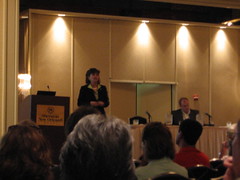 Continuing the afternoon of LITA programs, Cathy DeRosa (of OCLC) and John Horrigan (of the Pew Internet & American Life Project) spoke for the President’s Program.
Continuing the afternoon of LITA programs, Cathy DeRosa (of OCLC) and John Horrigan (of the Pew Internet & American Life Project) spoke for the President’s Program.
DeRosa brought up the recent OCLC stat that only 1% of users start their searches for information at libraries. But interestingly, she also found a study conducted from 1947-1950 that concluded only 1% of users would go to a library for information about nutrition. The number one choice back then was a “professional resource” instead. The modern question is determining who or what those professional resources are that people use today. But the dual 1% stats aren’t to say that library use hasn’t dropped. ARL stats show that college reference desk questions have dropped about 50% since 1991.
On social software and the like, DeRosa stated that a philosophy of ‘if you build it, they will come’ no longer applies. Now, the users are building it themselves. But the most shocking stat that she brought up, to me, is that 86% of users decide the trustworthyness of information based mainly on “personal knowledge and common sense”. Librarians need to help users build a better toolkit for the job.
Horrigan spoke more on the development of the internet’s infrastructure in America, and how it has affected society. Broadband connections are penetrating to all demographics, and upgrading to higher speed has a profound impact on internet use and engagement. Net access also reduces uncertainty in all areas – people use it to make major life decisions, and end up involved more in civic matters. 18% of users have remixed some sort of content, and 43% of all actively looking singles have looked for a date online at least once. For young users, the net both replaces old forms of media consumption and sets them in motion.
My favorite thought from his talk: “Does the long tail thicken the leading edge?” To explain, the abundance of obscure content available thanks to the internet (think of all the low selling books on Amazon that you won’t find in stores) could spur users to learn more advanced techniques to better sort and find that content. Thus, they become part of the leading edge of technology users. I also liked the idea that attention will be the new scarce commodity – and that librarians can help to allocate it. We’re already trusted and networked sources, after all.
In the Q&A afterwards, it came up that about 85% of users are confident of their searching abilities. Horrigan admitted that more research is necessary to determine just how skilled they are in reality. I’d love to see that data.